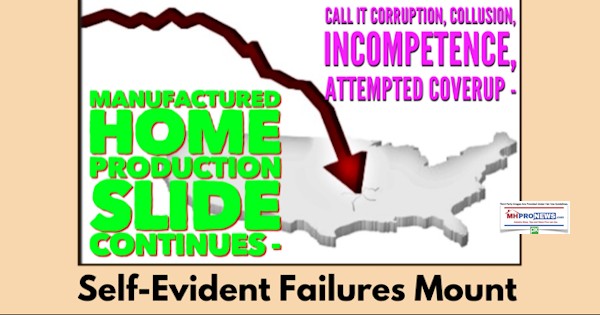
The Daily Business News on MHProNews starts this report with the release from the Manufactured Housing Association for Regulatory Reform (MHARR) on the new HUD Code manufactured home shipment data for December 2018.
We will then turn to some additional analysis and commentary on the closing totals for 2018.
https://manufacturedhousingassociationregulatoryreform.org/hud-code-manufactured-home-production-decline-persists-time-for-action-not-excuses/
You can read MHARR’s analysis on their website, by clicking on the text/image graphic above – or continue here below for their complete text, which will be followed by our analysis and commentary which follows their release.
HUD Code Manufactured Home Production Decline Persists – Time for Action not Excuses
Washington, D.C., February 4, 2019 – The Manufactured Housing Association for Regulatory Reform (MHARR) reports that according to official statistics compiled on behalf of the U.S. Department of Housing and Urban Development (HUD), HUD Code manufactured home production declined again in December 2018. Just-released statistics indicate that HUD Code manufacturers produced 5,943 homes in December 2018, a nearly 18% decline from the 7,245 new HUD Code homes produced during December 2017. On a cumulative basis, then, industry production for 2018 totaled 96,555 homes, a 3.9% increase over the 92,902 HUD Code homes produced in 2017.
Annual HUD Code industry production totals for the past ten years – from 2009 to 2018 – are thus:
- 2009 – 49,683 homes
- 2010 – 50,056 homes
- 2011 – 51,618 homes
- 2012 – 54,881 homes
- 2013 – 60,228 homes
- 2014 – 64,334 homes
- 2015 – 70,544 homes
- 2016 – 81,136 homes
- 2017 – 92,902 homes
- 2018 – 96,555 homes
While the four-consecutive-month decline in industry production that began in September 2018, as previously noted by MHARR, is disconcerting, continuing strength in the broader economy, as well as the exceptional quality and value of today’s HUD Code manufactured homes, demonstrate – once again – that constraints on industry sales and production levels exist primarily, if not exclusively, within the post-production sector, as was detailed by MHARR in the January 2019 edition of “MHARR: Issues and Perspectives.” And, while those constraints, including exclusionary and discriminatory zoning and placement restrictions, as well as wholly inadequate consumer financing support from Fannie Mae, Freddie Mac and Ginnie Mae, are quite real and extremely damaging to both the industry and American consumers of affordable housing, the remedies for those constraints are also quite real and already in existence, in the form – among other things – of the “Duty to Serve Underserved Markets” (DTS) provision of the Housing and Economic Recovery Act of 2008 (HERA) and the enhanced federal preemption of the Manufactured Housing Improvement Act of 2000. In short, the industry and consumers do not need new laws. What is sorely needed, rather, is a willingness to aggressively advance and fully implement all aspects of these existing laws, instead of chasing after illusions – i.e., new laws that, even if enacted by a politically-divided Congress, would take still more years to implement.
MHARR, as a key proponent of both DTS and the enhanced preemption of the 2000 reform law, will continue to aggressively advance the full implementation of both provisions to remedy the post-production limitations that continue to be the primary obstacle to the ability of the industry to achieve its full potential for all families – at every rung of the economic ladder – seeking to achieve the American Dream of homeownership.
A further analysis of the official industry statistics shows that the top ten shipment states from the beginning of the industry production rebound in August 2011 through November 2018 — with cumulative, monthly, current year (2018) and prior year (2017) shipments per category as indicated — are:
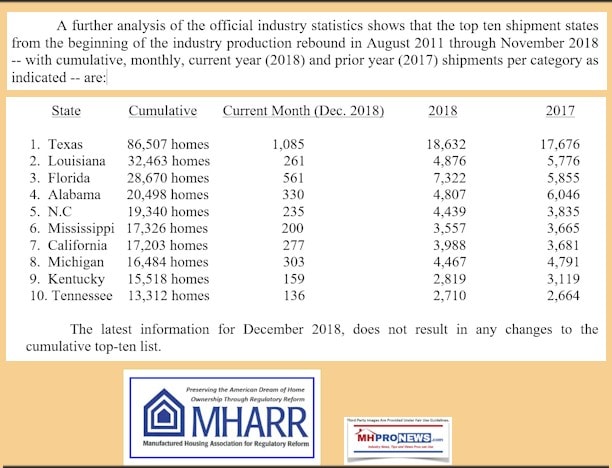
The latest information for December 2018, does not result in any changes to the cumulative top-ten list.
The Manufactured Housing Association for Regulatory Reform is a Washington, D.C.-based national trade association representing the views and interests of independent producers of federally-regulated manufactured housing.
— 30 —
First, in fairness and accuracy, one must note that the Manufactured Housing Institute (MHI) has stated the slide in new home production via their data release to members too. However, MHI has not raised any alarms. Quite the contrary, the Arlington, VA based trade group has touted “momentum” in their own materials.
While an MHI attorney specifically complained about the use of this graphic, below, MHI arguably KNEW what as about to occur, per our sources with MHI. Rephrased, MHI produced this video touting “momentum” knowing that production totals were about to show a decline.
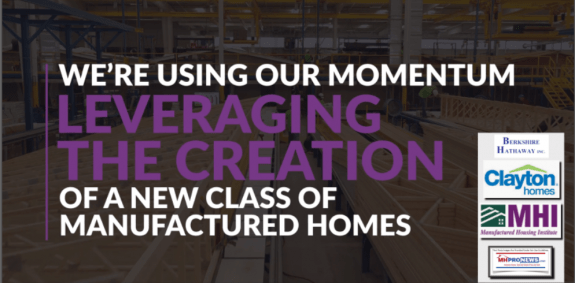
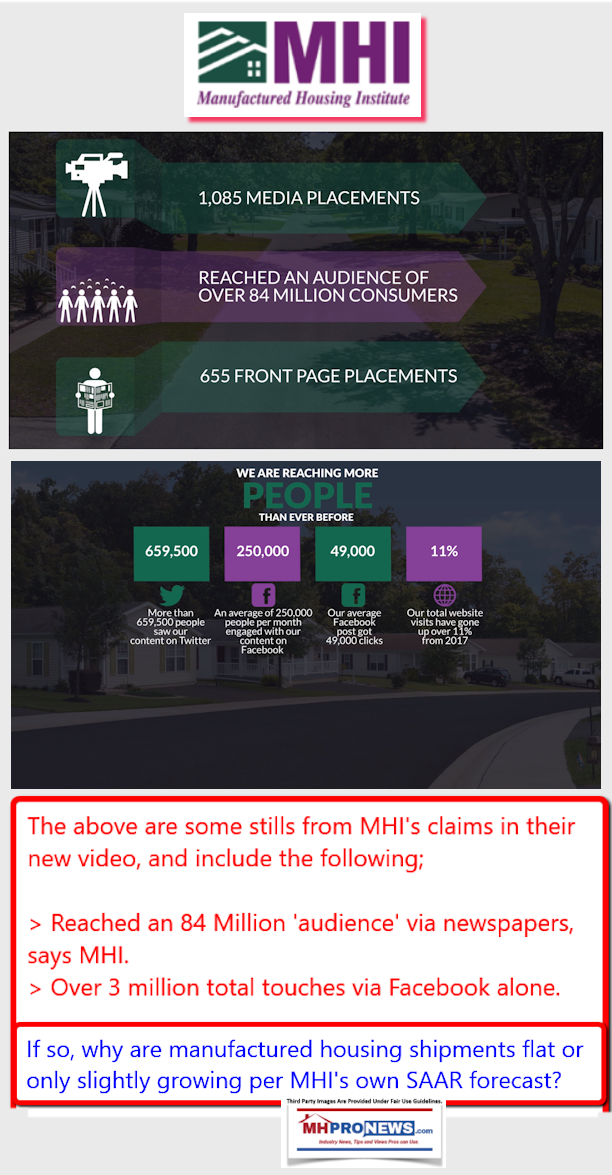
Their promotions are red-herring, razzle-dazzle, whatever phrase one might call it, besides an attempted deception – a ‘cover up,’ in that sense.
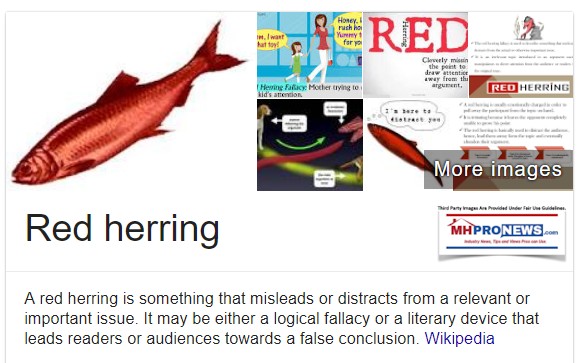
Let’s look at the data from MHARR above, through a different lens.
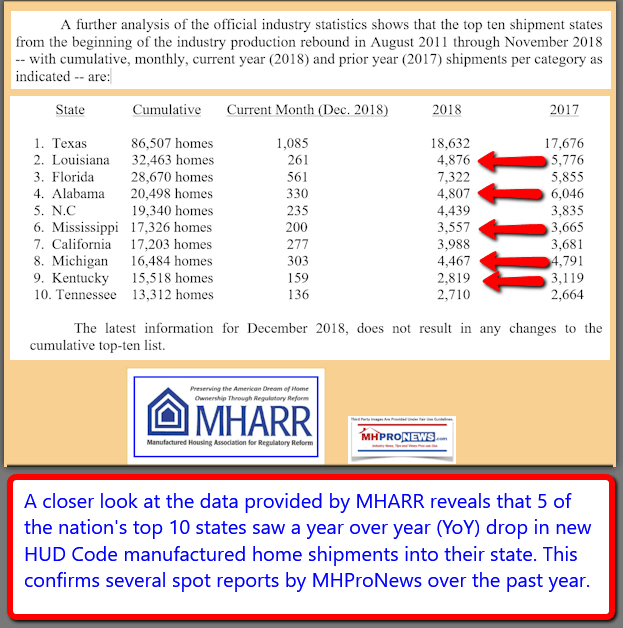
The Arlington-based association have used MHI surrogates to echo increasingly self-evidently false impressions. MHI’s members include the top 3 producers. They therefor could or should have known the coming totals, well in advance of the industry at large. Yet MHI and their amen-corner connected trade publishers are still singing sunshine and roses. What credibility do those MHI mouthpieces have, given the stubborn facts?
While some sign ‘amen’ to all that MHI says, meanwhile, the new manufactured home shipment levels have demonstrably dropped. Facts are #NettlesomeThings.
Numbers of state associations pass along MHI “housing alerts” and ‘news updates’ without any critical analysis. That’s not to condemn all state associations and their executives — some of them are reliable sources for us. But those that do so feel apparently feel trapped.
While mainstream housing, multifamily building, or RV shipments have soared, manufactured housing is snoring. While there is a modest rise at the first of the year, it was almost wiped out during the drop of last 4 months of 2018.
As MHProNews recently reminded readers, 4 years ago, Richard ‘Dick’ Jennison assured manufactured housing professionals in front of a live audience, caught on video, that the industry could do 500,000 new home shipments. Previously, MHI projected 107,000 shipments for 2018. Now, the industry fell thousands of units short of even 100,000.
MHI CEO Dick Jennison’s Pledge – 500,000 New Manufactured Home Shipments
The reason we keep reminding readers of this video of MHI’s CEO Jennison is that he signaled their slow growth at the time. Jennison’s words, on camera.
The graphic below was produced prior to the final totals that we now have in hand. It will have to be updated, as it is 3,445 units too high. Nevertheless, it is still more accurate on the GDP contributions at retail of manufactured homes to the U.S. economy. Why is it that MHI can maintain – with a straight face – inaccurate information?
But the point of the graphic below is to highlight the opportunity, vs. our industry’ truly meek performance.
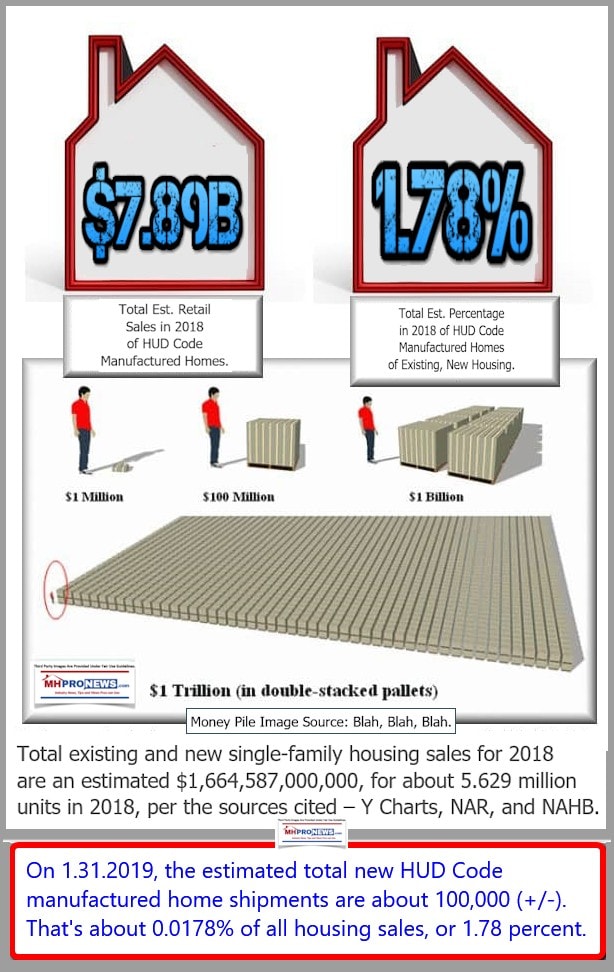
Here is the simple logic.
MHI either
- Knows how to grow manufactured housing, but is not doing so.
- Does not know how to grow manufactured housing, but postures through videos and other tools that they are properly promoting the industry.
- Some combination of the above 2.
Are any of those outcomes acceptable? Isn’t this the latest example of why deceptive trade practices should be part of a legal investigation of MHI?
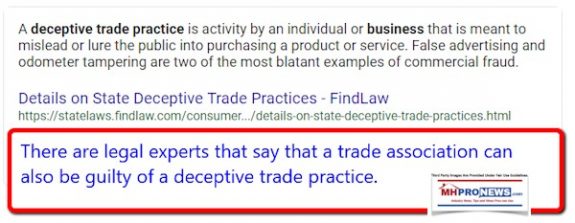
The need for a new, post-production association is becoming ever-more-clear. Instead of explaining themselves, or defending the industry against mainstream media or other problematic errors about manufactured housing, why are they spending legal dollars threatening MHProNews?
MHI has made MHProNews part of the narrative, by directly and indirectly hiring attorney(s). Okay, aren’t their deeds once more showing their hand? MHI won’t defend the industry, nor are they successfully promoting the industry, but they are willing to spend money attacking those that are reporting the facts about their failures?
It is the Omaha-Knoxville-Arlington axis and their allies that have ducked the issues.
Let’s close with Mark Weiss, JD’s, apt summary from the above.
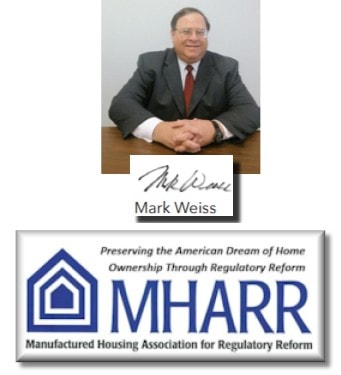
That’s the vexing reality. That’s “News through the lens of manufactured homes, and factory-built housing” © where “We Provide, You Decide.” © ## (News, analysis, and commentary.)

NOTICE: You can get our ‘read-hot’ industry-leading emailed headline news updates, at this link here. You can join the scores who follow us on Twitter at this link. Connect on LinkedIn here.
NOTICE 2: Readers have periodically reported that they are getting a better experience when reading MHProNews on the Microsoft Edge, or Apple Safari browser than with Google’s Chrome browser. Chrome reportedly manipulates the content of a page more than the other two.
(Related Reports are further below. Third-party images and content are provided under fair use guidelines.)
1) To sign up in seconds for our MH Industry leading emailed news updates, click here.

2) To pro-vide a News Tips and/or Commentary, click the link to the left. Please note if comments are on-or-off the record, thank you.
3) Marketing, Web, Video, Consulting, Recruiting and Training Re-sources

Related Reports:
You can click on the image/text boxes to learn more about that topic.
Bridging Gap$, Affordable Housing Solution Yields Higher Pay, More Wealth, But Corrupt, Rigged Billionaire’s Moat is Barrier – manufacturedhomelivingnews.com
America woke up today to division. But perhaps 75 percent (+/-) of the nation’s people could come together on a plan that demonstrably could do the following. Increase the U.S. Gross Domestic Product (GDP) by some $2 Trillion Annually, without new federal spending.
The Masthead
” Tony…as I think you know, it’s ALWAYS been my position that lease option and rent to own are illegal if they are a “workaround” for chattel financing, which is what most such schemes are …” – MH Industry attorney, not an association exec, in off-the-record comment about his legal perspective about the issue that follows.
“The Illusion of Motion Versus Real-World Challenges” | Manufactured Housing Association Regulatory Reform
Motion – or, more accurately, activity – in and of itself, is not necessarily synonymous with, or equivalent to, realprogress, or, in fact, any progress at all.
MHARR Recommending Independent Collective Representation for Post-Production
Washington, D.C., November 15, 2017 – The Board of Directors of the Manufactured Housing Association for Regulatory Reform (MHARR) has authorized the public release of a comprehensive internal study by the Association of the past, present and future representation of the post-production sector (PPS) of the federally-regulated manufactured housing industry.

























